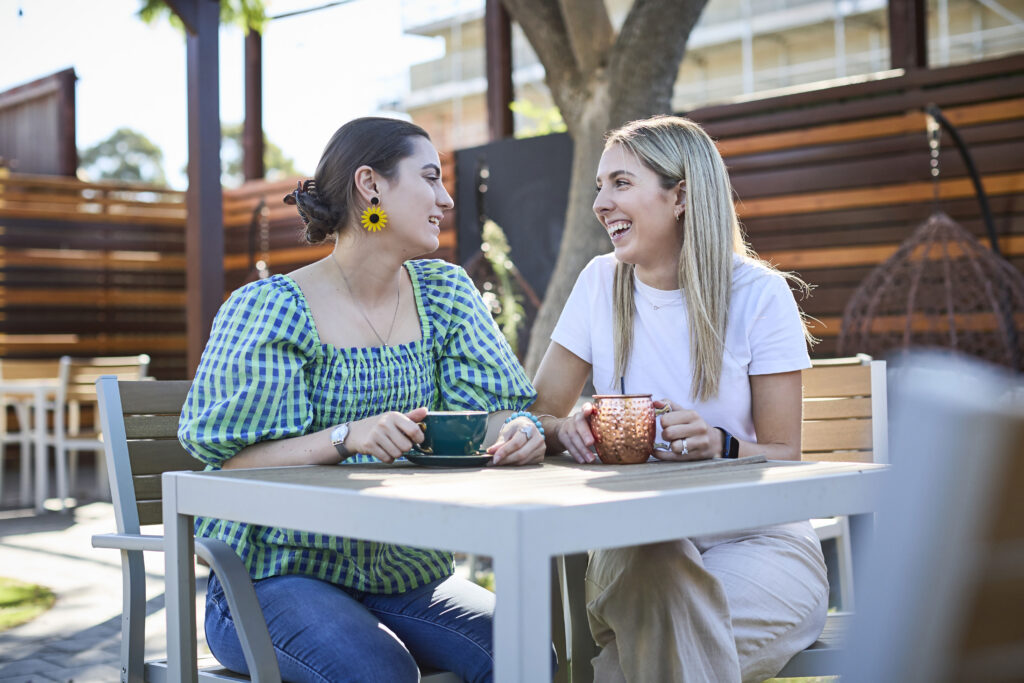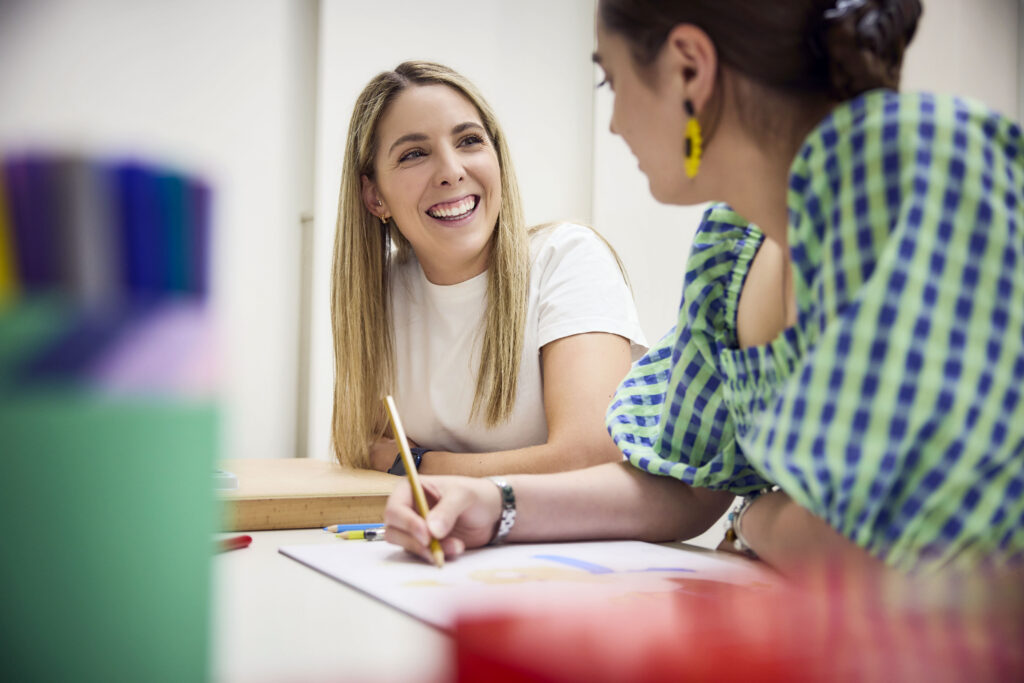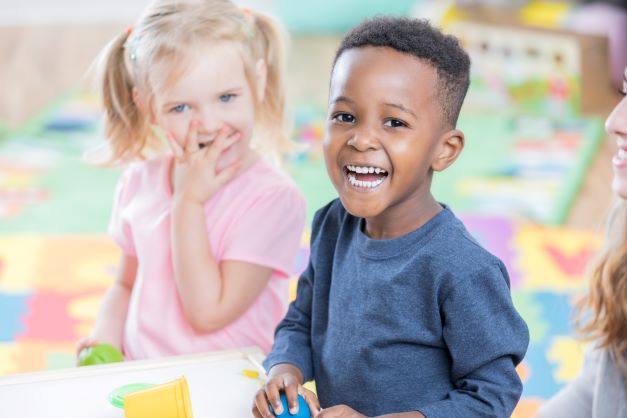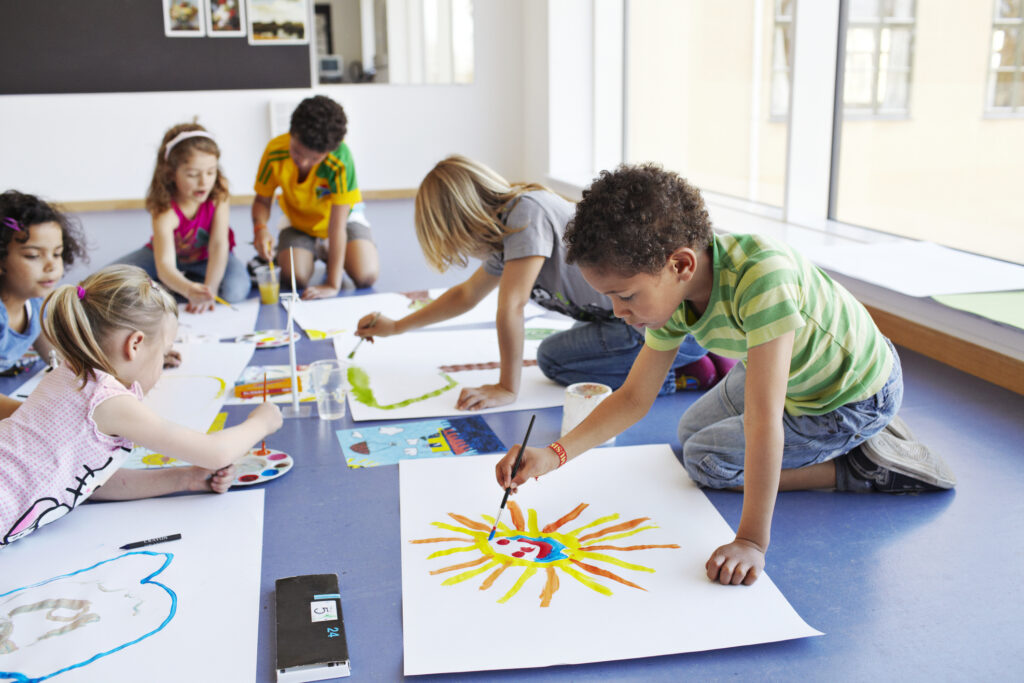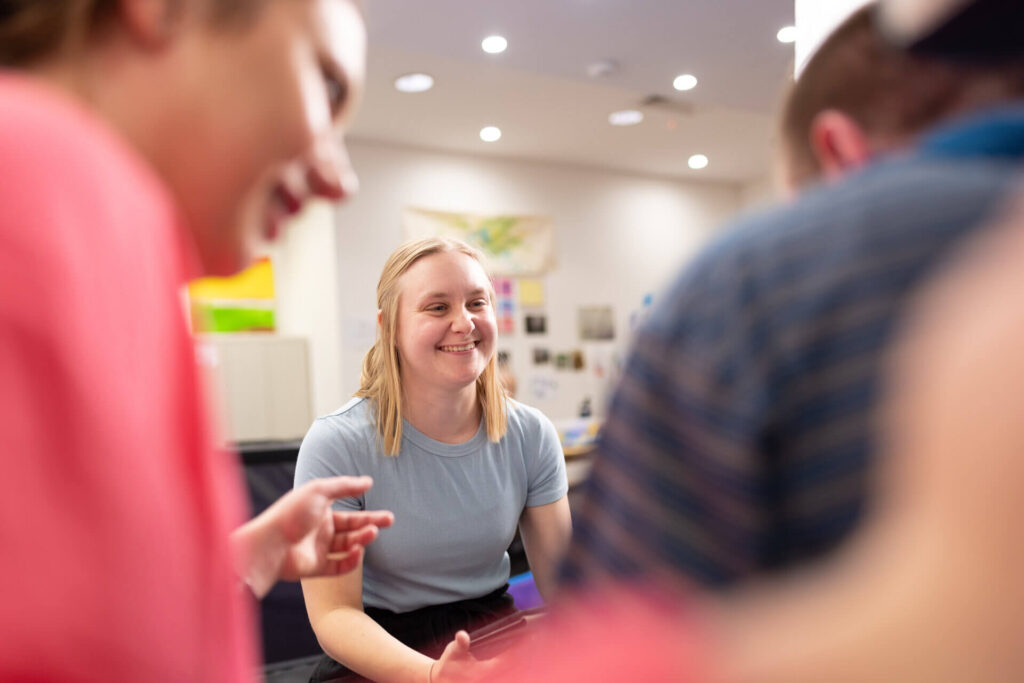Child development – the role of gross motor skills birth to 18 months
By Lyndsay Currie. Practice Principal, Early Start Australia Deakin and Kippax ACT, and Early Start Australia Queanbeyan NSW.
Child development covers a whole range of skills that a child must master over their lifespan and are most often categorised into 5 domains.
- Physical skills – fine motor and gross motor skills
- Sensory awareness – being able to register and respond to sensory information.
- Cognition – having the ability to learn and problem solve
- Speech and language – being able to use and understand communication
- Social interaction and emotional regulation – the ability to interact with others appropriately
These domains of development are interrelated, so when a child progresses in one domain it will influence the progress in other domains of development.
For example, once a baby has learned to reach out and grasp a toy (gross and fine motor ability) the opportunity for play and exploration opens and cognitive development begins.
All children develop at different rates; however, the developmental milestone charts provide a general idea of the changes to expect as you child gets older.
It is important for parents to refer to these developmental charts to pick up any difficulties or delays their child may be showing.
Gross motor skills are one of the first skills your child will develop, and consequently any delay in gross motor skills can have a significant impact on other domains of your child’s development.
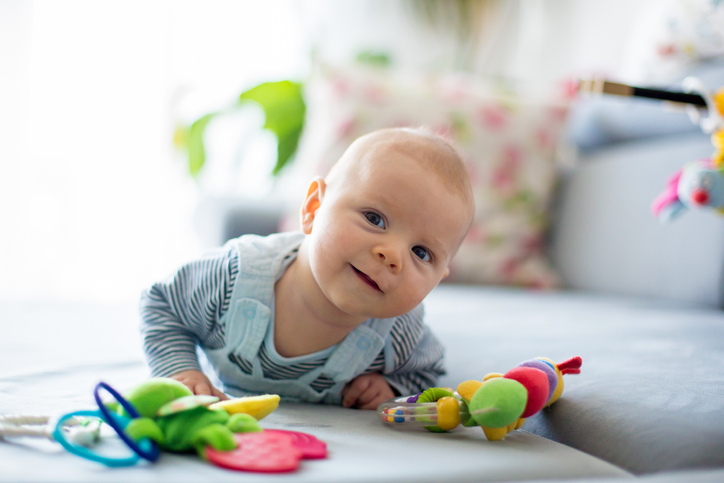
Gross motor skills – what are they?
The overall term ‘motor skills’ refers to a set of physical skills that enable children to perform the movements and tasks needed for everyday tasks, from feeding themselves to moving from place to place.
Motor skills comprise of two groups – gross motor skills and fine motor skills.
- Gross motor skills are full-body movements that require the use of balance, coordination, and physical strength of large muscles, to move the arms, legs, and trunk. Gross motor skill examples include rolling, crawling, standing, walking, climbing, and jumping.
- Fine motor skills are more refined movements with more precise and deliberate actions. Examples include holding a pencil, cutting with scissors, picking up small items, and holding utensils correctly when eating.
Babies develop gross motor skills first, and they can be seen as the foundations for development of fine motor skills, e.g. a baby must be able to bring their arms together (gross motor skill) before they can learn how to pass a toy from hand to hand. (fine motor skills).
Gross motor movements can be categorised as follows:
- Locomotor activity – this is movement from one spot to another. E.g. rolling, crawling, walking, running, climbing, leaping, jumping, hopping, galloping, and skipping.
- Non-locomotor activity or stability skills – these are related to balance and weight transfer. E.g. standing on one foot, bending, stretching, twisting, turning, swinging, swaying.
- Manipulative skills – making objects move in a variety of ways. E.g. throwing, kicking, striking, and catching.
Typical development of gross motor skills
Gross motor skills start developing in infancy and keep improving throughout childhood.
This process can be described as a series of distinct stages, where mastering each stage prepares your baby’s progression to the next one.
Babies learn from head to toe. As babies grow, they first develop control in their neck and trunk and then they grow in their control of their shoulders, elbow, wrist, and fingers.
The same goes for the lower body. Control begins from the hips then progresses to control in the legs, feet, and toes.
This is seen when your baby learns to first lift their head, then push up with their arms, then sit up without support, then push up to hands and knees, then crawl, and finally walk.
Click here to access tables and graphs presenting the windows of achievement of the of the six gross motor milestones.
What are the key gross motor milestones in the first 12-18 months?
Tummy Time
Tummy time is essential from the very beginning to help you baby to develop their head control and neck muscles.
It can help them to strengthen their arms as they begin to prop, which in turn will lead to developing their skills in rolling.
The strengthening of their arms will also play a role in the development of their fine motor skills.
Tummy time should be practiced 3-4 times a day when your baby is awake and alert.
Tummy time must always be supervised.
Rolling
Why is rolling important?
Rolling over is one of the first and most important milestones for a baby to achieve as it is the first time a baby experiences independent mobility.
Rolling stimulates babies’ tummy muscles, which need to be strong for them to achieve future milestones such as sitting and crawling.
Rolling also requires the baby’s body to rotate or twist naturally, helping to develop two important senses: vestibular (balance) and proprioceptive (body awareness) which in turn is important for balance skills at a later stage.
What happens if your baby has a delay in rolling?
All babies will typically roll from their tummies to their back by 4 months old.
By 6 months they can roll from their backs to their tummies.
A delay beyond 6 months of age in the development of rolling will have an impact on your child’s balance and coordination, their ability to interact with toys, their ability to move independently to interact with toys and people.
If your baby cannot roll in either direction by six months old, you should seek the advice of your GP or local paediatric physiotherapist.
Delays can be caused by several things such as prematurity, an underlying hereditary or congenital problem, the child’s environment, and opportunities for repeated practice.
How to promote rolling:
- Minimise time spent in baby equipment (bouncy chairs/exer-saucers)
- Plan for lots of tummy time with a variety of toys to motivate your baby
- Play time on back should involve your baby interacting with their feet, this helps them to roll to the side.
- Time spent in side lying will also promote rolling to front or back if a desired toy is placed just out of reach
Crawling
Why is crawling important
Crawling plays a major role in strengthening a baby’s upper body.
As babies put weight through the shoulders, forearms, wrists, hands, and fingers, they are developing strength, dexterity, hand-eye coordination, and sensory integration that will be used later in life to support many skills.
Babies are also fine tuning their visual perceptual skills which helps with reaching accuracy and interpreting the 3D world.
Crawling is a complex movement that requires both sides of the brain to work together to control both sides of the body (known as bilateral coordination).
This will allow the child to perform complex tasks in the future such as standing on one leg to put trousers on or holding a piece of paper steady while writing.
What happens if your baby has a delay in crawling?
Your baby may be able to get themselves into the crawling position from the age of 6 months.
Many babies will commando crawl first.
Most babies will be able to move independently using commando or actual crawling between eight-12 months.
If your baby is not showing any interest in crawling or is bottom shuffling as a way to move by 12 months you should seek the advice of your GP or local paediatric physiotherapist.
If a baby skips the crawling stage (including bottom shuffling) it can affect several areas of their physical development.
As crawling increases the strength of both trunk and upper limbs, babies who did not crawl can have significantly weaker core muscles.
This will have an impact on the child’s ability to stabilise themselves in sitting, which in turn can have an impact on concentration, handwriting and reading in the future.
Crawling increases the weight bearing on hands which helps develop the arches and muscles of the hands in preparation for fine motor development, e.g. holding a pencil- often children who skipped the crawling stage have messy handwriting.
As crawling promotes bilateral coordination, babies who did not crawl can often have coordination difficulties as children, commonly seen as difficulty in dressing, self-feeding, and sports.
How to help promote crawling:
- Minimise time spent in baby equipment (bouncy chairs/jolly jumpers)
- Lots of tummy time, provide support to your baby to help them get into the hands and knees position.
- Place toys slightly out of reach when they are on all fours, encourage them to reach out with one hand, that will help them to learn to transfer weight form one hand to the other.
- Place your baby over a rolled-up towel to support them in kneeling.
- Encourage them to crawl over cushions on the floor.
Sitting
Why is sitting important?
Sitting on the floor requires your baby to use all their muscles of the trunk, legs and arms as they wobble to remain upright against gravity.
They will use both their hands at first to prop themselves up, and their legs will move to counteract any loss of balance.
Gradually they will be able to reach out with one hand, and then to free both hands to play with toys.
This helps to develop their postural muscles, balance and coordination, a skill which is necessary to help them in crawling and standing.
Once a baby has learned to sit independently, they will then need to learn how to move into and out of this position.
This is often achieved by rotating onto all fours.
This step is a vital addition for crawling, as the baby can now move into crawling to travel to a toy, they can then move into sitting to play with the toy.
This is a huge step in purposeful movement for a child.
What happens if your baby has a delay in sitting?
Most babies can sit with support from four months of age, often gaining independent sitting by between six-eight months old.
If you baby is not able to floor sit independently by the age of nine months you should seek advice from your GP or your local paediatric physiotherapist.
If a baby cannot sit independently, mobility or purposeful movement will be affected.
Postural strength and balance will be delayed, further impacting their ability to learn to stand/walk and balance.
A child cannot learn to walk if they have not gained postural control in sitting.
How to encourage floor sitting:
- Sit your baby between your legs on the floor, provide support with your hands around their trunks, as they become more confident, lower the support to just around the hips
- Once they can sit without support, surround them with cushions or pillows and place their toys between their legs for easy reach
- Once they can sit without using their hands for support, start placing their toys to either side of them to encourage then to twist and reach sideways to retrieve them. This will begin to develop their dynamic balance and weight shift.
Pull to standing
Once your child has mastered independent floor mobility in crawling or bottom shuffling they will quickly want to pull to stand either by using your hands as support, or more often by pulling up at a surface.
This is an important stage in babies’ development as it begins to prepare their postural muscles and skeletal alignment for the upright position required for walking.
It is also a key stage in babies hip development by forming a secure joint alignment and strengthening the muscles around the hip ready for cruising and walking.
What happens if your baby has a delay in standing?
Most babies will pull to standing between 8-12 months.
Please seek advice form your GP or local paediatric physiotherapist if your child is not pulling to stand by 12 months of age.
How to promote pull to standing:
- Make sure your environment is safe for pull to standing activities
- Hold some toys up and encourage your child to climb up you to reach them
- Gradually increase the height that you place their toys – on the sofa and encourage them to crawl or bottom shuffle to the sofa. Guide them to stand to reach the toys. You might want to provide some support while they practice the first few attempts.
- Progress this by getting them to squat down to pick up toys from the floor and place them back on the sofa
Cruising
Cruising is an important pre-walking stage of development as it is the beginning of you child’s ability to shift weight from one foot to the other, and to develop the balance mechanisms required to do so without toppling over.
They will begin with side stepping around furniture, and eventually move to taking one or two steps forwards (or backwards) while holding on with one hand.
What happens if your baby has a delay in cruising?
This can often happen when you have spent time too much time helping your child to walk by holding their hands. It is important to not miss the cruising stage.
Most babies will begin to cruise between 9-12 months, but some can take longer.
If your child is showing no interest in cruising by the age of 14 months seek advice from your GP or local paediatric therapist.
How to promote cruising:
- Place toys slightly out of reach on the sofa and encourage your child to sidestep to reach them
- Encourage them to navigate their way around the corner of the sofa or chair
- Stick pictures along the wall, standing at a wall encourage them to walk sideways along the wall
- Gradually encourage them to take one step between chairs
Assisted walking – walking
During the cruising stage most babies are equally happy for you to help them walk by holding their hands.
This is not actually helping them to learn to walk independently, as they rely on you to provide their balance and stability.
They do not have the chance to experience loss of balance, and consequently do not develop all the reactions that are necessary to support independent standing and walking.
Instead use your hands to support them around their shoulders or on the tops of their arms.
If they insist you hold their hands, then keep their hands below their shoulders.
What happens if your baby has a delay in walking?
Most babies are walking independently by the age of 12-16 months.
If your child is not walking at all by 18 months you should seek advice from our GP or local paediatric therapist.
How to promote walking:
You can use other items to help them develop their skills – using hula hoops or a towel can help them learn to walk with minimal assistance.
Push along toys such as toy shopping trolleys or strollers work well.
Once your child has gained in confidence try to encourage them to take one or two steps between two people.
Try to avoid holding your arms outstretched as this will only encourage them to launch towards you.
Keep you hands down low and offer praise when they reach you safely.
Summary
The gross motor skills that your child develops from infancy to 18 months establish an important foundation for the future development of many skills across the five domains of childhood development.
Missing key stages of gross motor development will impact not just a child’s ability to perform everyday tasks well, it can have an impact on self-esteem, behaviour and may reduce your child’s participation in achieving a healthy physically active lifestyle.
It is important to keep checking your child’s developmental milestones and seek help and advice early if you have concerns about their progress.




